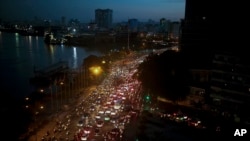Vietnam's capital, Hanoi, enjoyed little more than one month of clean air last year as pollution levels rose to match those of China's smog-prone capital, Beijing, preliminary findings of a new report showed.
Annual average air pollution in Hanoi in 2017 was also four times higher than the level deemed acceptable by the World Health Organization's air quality guidelines, according to a report by the Green Innovation and Development Center (GreenID).
And the situation is likely to get worse, according to the Hanoi-based nonprofit organization.
"A bit more than one month were days with good air quality," said Lars Blume, technical adviser at GreenID, which analyzed air monitoring data compiled at the U.S. Embassy in Hanoi.
"It is out of people's control — they have to go out and work — and in many cases it is hard to really feel whether air is good or bad," Blume told the Thomson Reuters Foundation.
Air pollution in Hanoi is caused by a number of factors, including a rise in construction work, an increase in car and motorcycle use, and agricultural burning by farmers, Blume said.
But research in the report suggests that heavy industries, like steel works, cement factories and coal power plants in areas near the capital, are also significant contributors.
Hanoi's air pollution is now worse than that of the Indonesian capital, Jakarta, the report showed, and things are unlikely to improve as Vietnam pushes ahead with plans to build more coal-fired power plants.
Exposure to high levels of air pollution, especially over the long term, can affect human respiratory and inflammatory systems, and can also lead to heart disease and cancer.
Acknowledging the problem, in mid-2016 the Vietnamese government launched a national action plan that sought to control and monitor emissions and improve air quality. Hanoi is planning to install 70 air monitoring stations.
The GreenID report criticized the lack of regulations on air quality, a lack of public awareness of the problem and a lack of effective measures to minimize the effects, such as home purifiers.
The Vietnamese government must install more air pollution monitoring stations across the country and make the data available to the public, Blume said.
Improved urban planning and investments in renewable energy and public transport systems are also needed, said the report, which is due to be published at the end of February.
Previous GreenID surveys showed a growing concern among the Vietnamese over the issue of air quality and a rise in respiratory problems among children, said Nguyen Thi Anh Thu, a researcher at the organization.










